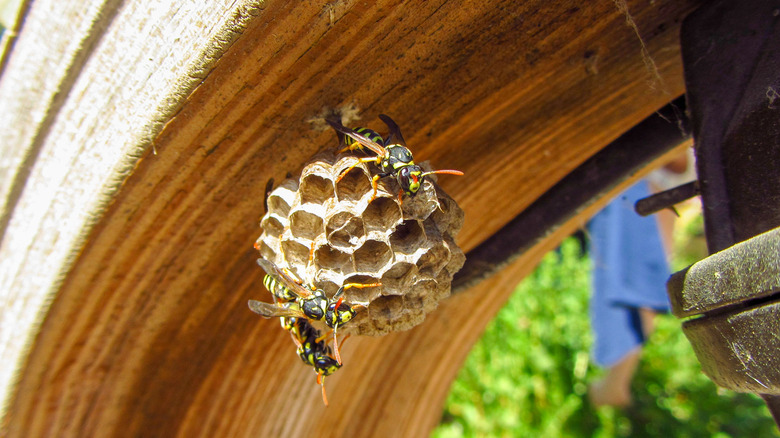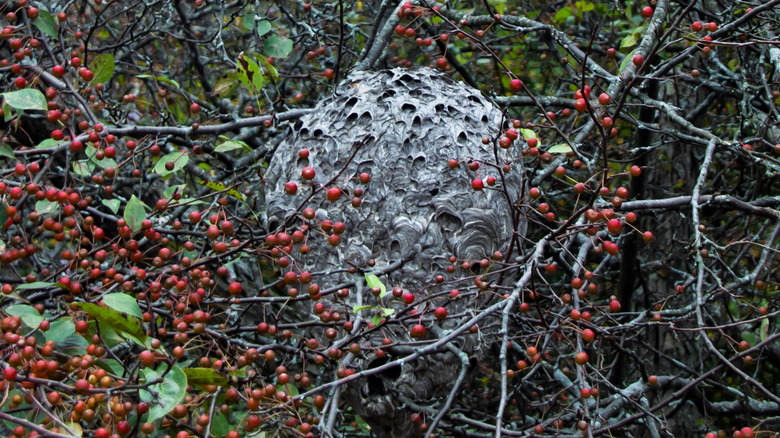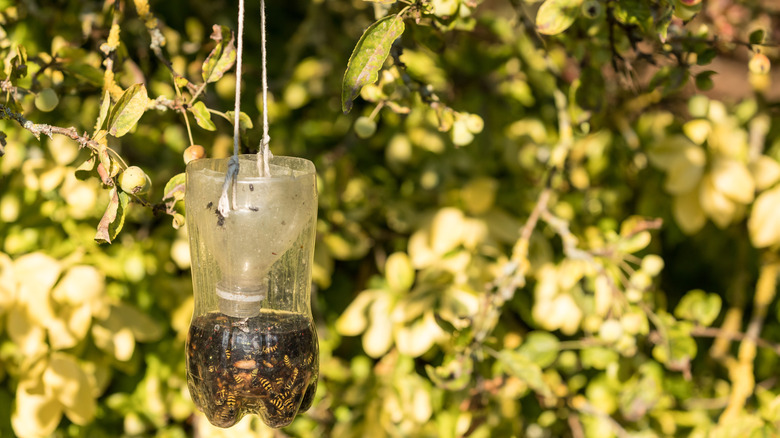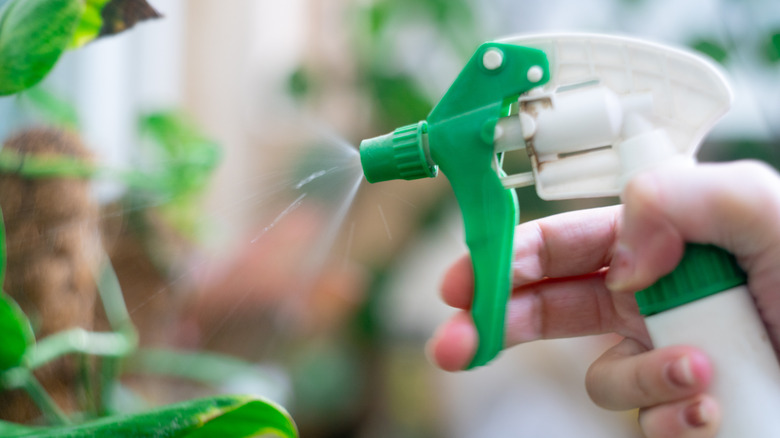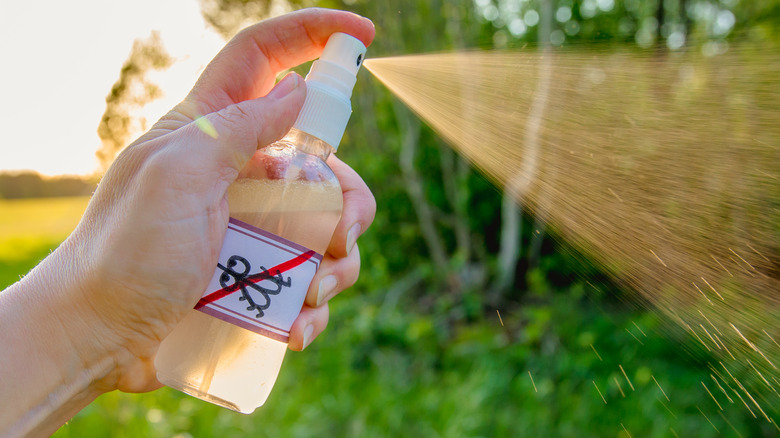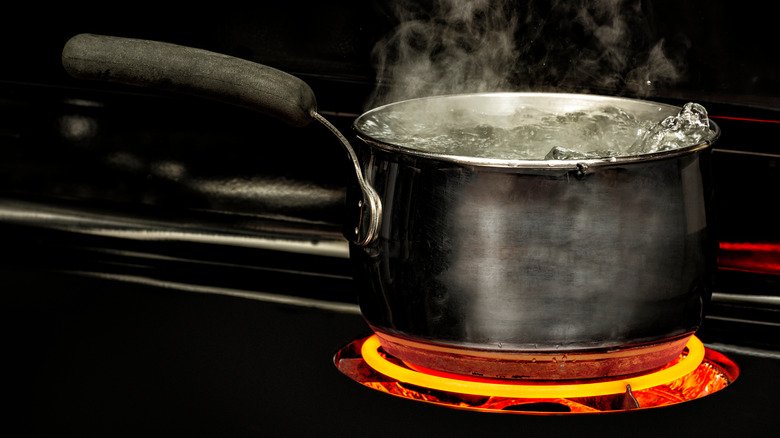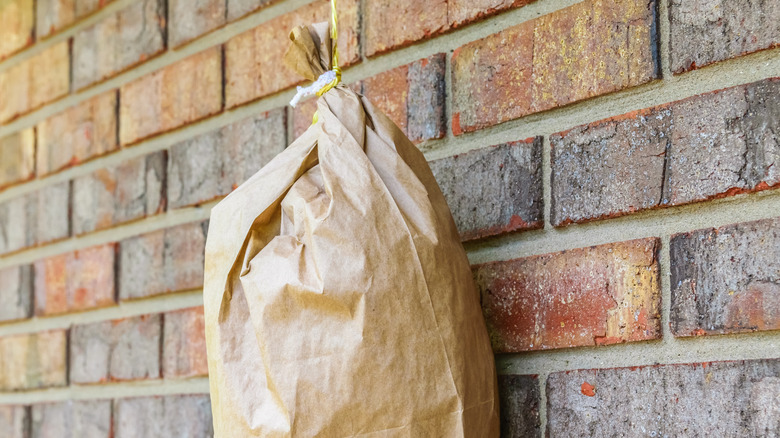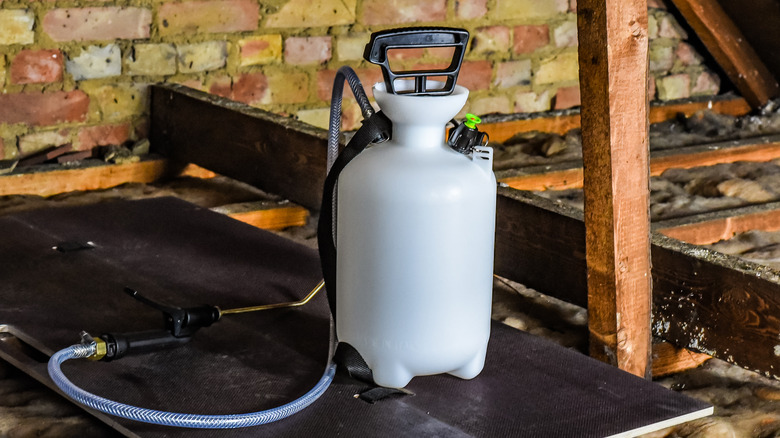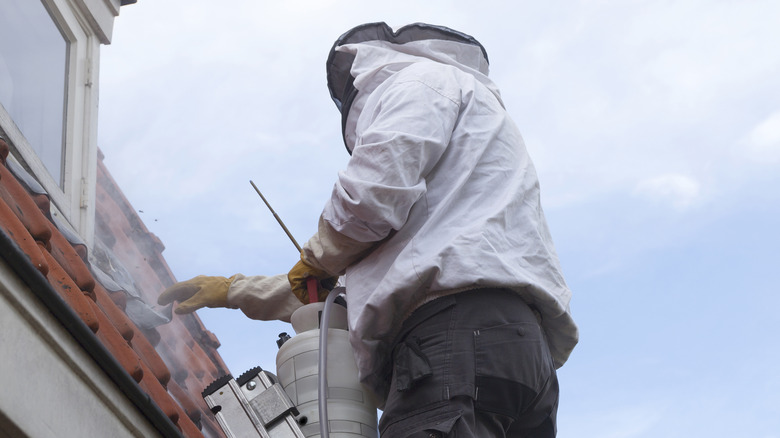8 Ways To Get Rid Of Wasps
As the weather warms up, you and your family might start planning some fun outdoor activities. You have cook-outs, volleyball games, or even some landscaping projects to look forward to. However, you might deal with an unwelcome visitor known as the wasp. And what can be more annoying than these insects hovering close by waiting for the slightest excuse to zero in and sting?
Fortunately, we've come up with ways to get rid of wasps, some of which are eco-friendly and others that involve chemical pesticides. Regardless of the method you choose, your yard, porch, and patio will remain wasp-free for the rest of the warm-weather season. However, there are two important precautionary measures to keep in mind. One is to exterminate the wasps just before the sun rises or soon after the sun sets when wasps are inactive, according to Terro. Another is to completely cover your face and body to protect from stings.
1. Create an unfriendly environment
Primarily, the best way to get rid of wasps relates to prevention. If possible, you can create an unwelcoming environment for these bothersome creatures. As noted in Gardening Know How, if you collect all fruits or berries that have fallen from trees or bushes, wasps won't become attracted to your area. They detect the scent of these items and right away, and try to move in and build their nests.
Also, you can keep your garbage cans tightly covered for the same reason: to keep from luring wasps to your home. Another tip is to keep the lid on any drinks that you have outside while working or playing. Furthermore, according to the Clemson University Cooperative Extension Service, you can keep nests from sticking by painting or varnishing surfaces. These maintenance measures keep wasp nests from sticking to the smooth surfaces, thus mitigating the increase in their population.
2. Build wasp traps
Along with clearing away all debris, you can construct your own wasp traps. As an effective way to get rid of wasps, building traps also provides a method that doesn't require chemical insecticides. Thus, this method offers a green alternative, as you can see in Good Housekeeping. First you take a 2 liter plastic bottle and cut off the top part about 3 inches from the neck. Next you'll fill the bottom part with sugar water and then turn the top part upside and slide it inside into the bottom half. You can set it on a flat surface close to the nest.
If you prefer to hang the trap, you can punch holes in both the top and bottom portions, thread some thin wire through, and hang the trap on a tree branch. Basically, the wasps enter the trap to get to the sweet liquid but can't exit.
3. Use soap and water
Yet another tried-and-true way to get rid of wasps is to spray their home with a mixture of soap and water. According to Smith's Pest Management, this hack proves to be both effective and easy if you follow the precautions of working early in the morning and wearing protective gear.
To create the spray solution, you'll add 2 tablespoons of dish soap of any brand to a spray bottle of water. From there, you can spray the mixture directly into the opening of the wasp's nest. This method also works well on a single wasp who's flying close by but with caution.
Another hack that's mentioned in the Green Pest Solutions blog is to use a sprayer, similar to a power washer, to spray a strong stream of water into the nest. This is sure to drown the wasps and destroy the nest in one treatment.
4. Apply herbal blends
Another green method of getting rid of wasps is to add essential oils to your mixture of soap and water. Per Good Housekeeping, the recipe for this DIY pesticide includes essential oils that are extracted from lemongrass, clove, and geranium. First, you'll mix the dish soap with the water in a spray bottle. Then, add a few drops of each type of essential oil to the mixture. If you shake the bottle after adding an ingredient, you'll ensure that solution is well mixed.
Also, you'll need to target areas where you've spotted nests in the past. This is because wasps have a tendency to return to the same location, but the oils will repel them. So you'll need to spray onto the soffits, eaves, and inside the corners of your porch. And don't forget the window ledges which are also comfortable spaces for wasps to congregate and nest.
5. Use boiling water
According to Bob Vila, you can also get rid of wasps by dumping boiling water into the nest. Again, this calls for protective gear to cover yourself from head to toe. Plus, you'll need to plan the treatment for the hours before sunrise or just after sundown to avoid a counter assault from the wasps.
Other than the preparation and timing, this method is also one of the simplest. You'll take a large pot or bucket of boiling water and pour it directly (and carefully to avoid burning yourself) into the nest. By doing so, you'll drown the wasps immediately and wreck the nest.
If by some chance the nest doesn't fall right away, or you still find a stray wasp or two lingering around it, you can wait a day or two to apply another treatment of boiling water which should allow the nest to detach and drop.
6. Drown the nest
If you have a nest that's hanging in an open area where you can get to it easily, there's another quick way to get rid of wasps, as noted in the Tree Hugger blog. Carefully get a durable bag and place it around the hanging nest. As quickly as possible, tie it securely, ensuring that nothing can escape. Then, you'll detach the nest from its spot and place it in a bucket of water. This time, the temperature is not of major importance since you'll drop a heavy object, like a rock, onto the bag to immerse it. As a result, the nest and its insect inhabitants will be immersed completely.
Just like the other methods, you should carry this procedure out when the wasps are not active. Most likely, this process works best if you're trying to get rid of a bald-faced hornet's nest which resembles an orb.
7. Spray with insecticide
While the eco-friendly methods of getting rid of wasps prove to be effective and safe, you might need to resort to using insecticide if you encounter a particularly stubborn wasp population. Plus, some products come with a sprayer that allows for application from a distance, as noted by This Old House. Likewise, you'll also find varieties of concentrated wasp insecticides that require mixing in your own sprayer which gives you more flexibility with distance. This option provides the safest strategy in getting rid of wasps as well.
Later, you can follow up with an aerosol spray that leaves behind a film or residue, or sprinkle a powder which also sets up a repellant barrier against wasps. This will make their return less likely. Regardless of your choice of insecticide, you should carefully follow the instructions on the product's label and apply the insecticide on a day that's not breezy.
8. Call an exterminator
Naturally, if you're leery about approaching a wasp's nest or if you're allergic to wasp stings, then calling an exterminator is your best option. Likewise, if you've found that using your own methods haven't effectively rid your property of these pests, then calling a professional is necessary. Furthermore, according to Pests.org, if you have applied chemical agents directly on the nests or sprayed the areas where wasps congregate, and that process still didn't work, then you should consult with a professional exterminator.
Oftentimes, the store-bought insecticides aren't as strong as those used by exterminators. Plus, they have the expertise that's necessary for using more potent chemicals along with the proper protective gear. Additionally, if you're dealing with a bad infestation that comes from more than one nest or a sizable one that contains a large wasp population, then an exterminator would be better equipped to tackle that job.

